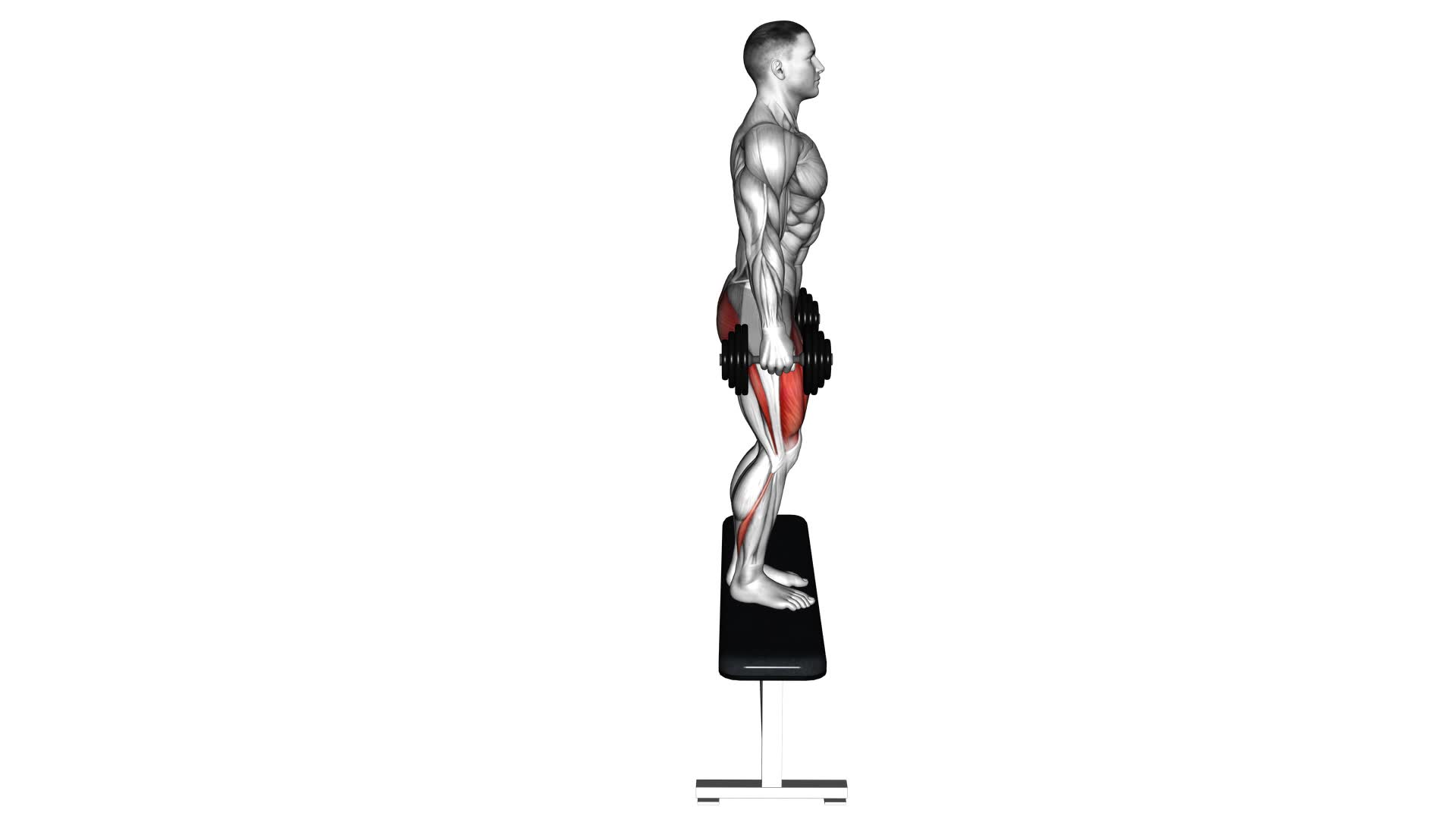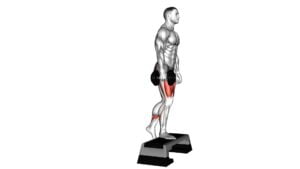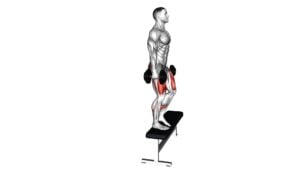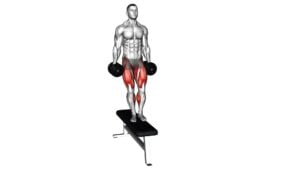Dumbbell Step up – Video Exercise Guide & Tips

Looking to level up your workout routine? Check out this video exercise guide and tips for the Dumbbell Step Up!
Watch This Exercise Video
This challenging exercise is a great way to target your lower body and build strength. In this guide, we'll show you the proper form and technique, variations to challenge yourself, and common mistakes to avoid.
Plus, we'll give you tips on how to incorporate this exercise into your workout routine and maximize your results.
Let's get stepping!
Key Takeaways
- Dumbbell step up targets multiple muscle groups simultaneously
- Proper form and technique is important to prevent injury
- Use variations and modifications to increase the challenge and target different muscles
- Maximize results by tracking progress, setting specific goals, and incorporating compound exercises
Benefits of Dumbbell Step Up
To maximize your workout routine, you should incorporate dumbbell step ups into your exercise regimen because they offer a wide range of benefits.
Dumbbell step ups are a versatile exercise that can be modified to suit your fitness level and goals. One of the main benefits of this exercise is that it targets multiple muscle groups simultaneously. When performing a dumbbell step up, you engage your quadriceps, hamstrings, glutes, and calves. This makes it an excellent exercise for building lower body strength and improving overall stability.
Another benefit of dumbbell step ups is that they can be easily modified to increase or decrease the intensity of the exercise. If you're a beginner or have limited mobility, you can start with a lower step height and lighter dumbbells. As you become more comfortable and stronger, you can increase the step height and use heavier dumbbells to challenge yourself further.
In addition to building strength, dumbbell step ups also improve your balance and coordination. By stepping up onto a raised platform, you're forced to stabilize your body and maintain control throughout the movement. This can help prevent injury and improve your performance in other activities.
Proper Form and Technique
To perform the dumbbell step up exercise with proper form and technique, it's important to focus on maintaining proper body alignment throughout the movement. This includes keeping your chest up, shoulders back, and core engaged.
Additionally, you should be mindful of preventing common mistakes such as using momentum to lift the dumbbell or allowing your knee to cave inwards during the step up.
Body Alignment During Exercise
Maintain proper body alignment throughout the dumbbell step-up exercise by engaging your core and keeping your shoulders back and down. Proper body posture is essential to ensure that you're performing the exercise correctly and effectively.
Engaging your core muscles will help stabilize your body and prevent unnecessary strain on your lower back. Keeping your shoulders back and down will help maintain a neutral spine position and prevent rounding of the shoulders.
This alignment will ensure that the proper muscles are being engaged and that you're maximizing the benefits of the exercise. By maintaining this alignment, you'll also reduce the risk of injury.
Now, let's move on to preventing common mistakes during the dumbbell step-up exercise.
Preventing Common Mistakes
Avoid common mistakes and ensure proper form and technique during the dumbbell step-up exercise by using a light to moderate weight dumbbell. By doing so, you can prevent common misconceptions and reduce the risk of injury.
One common mistake is using too much weight, which can lead to poor form and strain on the muscles and joints. Another mistake isn't maintaining proper body alignment, such as keeping the chest up and shoulders back throughout the exercise.
It's also important to avoid rushing through the movement and to focus on controlled and deliberate steps. Remember to engage the core and use the glutes to power through each step.
Variations to Challenge Yourself
You can challenge yourself with various variations of the dumbbell step up exercise. These advanced modifications won't only increase the difficulty of the exercise but also enhance muscle activation.
One variation you can try is the single-leg dumbbell step up. Instead of using both legs, you'll perform the exercise using only one leg at a time. This variation requires more balance and stability, thereby increasing the intensity of the workout and targeting the muscles in your legs even more.
Another challenging variation is the lateral dumbbell step up. Instead of stepping up onto a box placed directly in front of you, you'll position the box to the side and step up laterally. This variation targets your glutes and outer thighs, providing a great workout for your lower body.
For an added challenge, you can incorporate a knee lift at the top of the step up. This movement increases the activation of your core muscles and further engages your hip flexors.
Common Mistakes to Avoid
To maximize the effectiveness of your dumbbell step up exercise, it's crucial to be aware of common errors to steer clear of. Here are four common mistakes to avoid and tips for maintaining proper form:
- Using too much weight: One of the most common mistakes is selecting a weight that's too heavy. This can lead to poor form and an increased risk of injury. Start with a weight that allows you to perform the exercise with proper technique and gradually increase the weight as you become more comfortable.
- Not stepping up fully: Make sure to fully extend your leg as you step up onto the platform. This will engage your glutes and hamstrings more effectively. Avoid shortening the movement by not fully extending your leg or not stepping up high enough.
- Leaning forward: It's important to maintain an upright posture throughout the exercise. Avoid leaning forward or hunching your shoulders. Keep your chest lifted and your core engaged to ensure proper alignment and maximize the benefits of the exercise.
- Neglecting balance: Balance is key in the dumbbell step up exercise. Take your time and focus on maintaining stability as you step up and down. Use your core muscles to stabilize your body and avoid excessive wobbling or leaning to one side.
How to Incorporate Dumbbell Step up Into Your Workout Routine
To incorporate dumbbell step up into your workout routine, start by including this exercise as part of your lower body strength training workouts. Dumbbell step up is a great exercise for targeting your glutes, quadriceps, and hamstrings. You can modify this workout by adjusting the height of the step or by increasing the weight of the dumbbells.
To begin, stand facing a step or platform with a dumbbell in each hand. Place one foot on the step and push through your heel to lift your body up onto the step. Keep your chest lifted and your core engaged throughout the movement. Slowly lower yourself back down to the starting position, and repeat with the opposite leg.
To target your glutes more, you can use a higher step or increase the weight of the dumbbells. If you want to focus on your quadriceps, you can use a lower step and decrease the weight. It's important to listen to your body and choose modifications that challenge you without causing pain or compromising your form.
Incorporating the dumbbell step up into your workout routine will help you build lower body strength and improve balance and stability. Remember to always warm up before exercising and consult with a fitness professional if you have any concerns or questions.
Tips for Maximizing Your Results
To maximize your results with the dumbbell step up exercise, it's important to implement effective workout strategies and goal-setting techniques.
By varying the height of the step and increasing the weight of the dumbbells over time, you can challenge your muscles and promote growth.
Additionally, tracking your progress and setting specific goals will help you stay motivated and focused on achieving the desired results.
Effective Workout Strategies
How can you maximize your workout results with effective strategies? Here are four tips to help you get the most out of your workouts:
- Increase workout intensity:
To maximize your results, you need to challenge your body. Gradually increase the intensity of your workouts by increasing the weight, speed, or duration of your exercises. This will help to stimulate muscle growth and improve your cardiovascular fitness.
- Incorporate exercise modifications:
If you've been doing the same exercises for a while, your body may have adapted to them. To continue making progress, try incorporating exercise modifications. This could include using different equipment, changing the angle or range of motion, or trying advanced variations of exercises.
- Focus on compound exercises:
Compound exercises, such as squats, deadlifts, and push-ups, engage multiple muscle groups at once. They're more efficient and effective for building strength and burning calories compared to isolation exercises. Make sure to include a variety of compound exercises in your workouts.
- Prioritize rest and recovery:
Rest is just as important as exercise when it comes to maximizing your results. Allow your body enough time to recover and repair between workouts. This will help prevent overtraining and reduce the risk of injury.
Goal-Setting Techniques
Are you wondering what goal-setting techniques can help you maximize your workout results?
Goal setting strategies are essential for staying focused and motivated during your fitness journey. Here are a few tips to help you set effective goals and track your progress.
First, make your goals specific and measurable. Instead of saying, 'I want to get stronger,' set a goal like, 'I want to increase my squat weight by 10 pounds in the next month.' This way, you have a clear target to work towards.
Additionally, break down your goals into smaller milestones. Celebrating these mini achievements will keep you motivated and make the process more manageable.
Lastly, track your progress regularly. Use a journal, app, or fitness tracker to monitor your workouts, weight, and measurements. Seeing your progress will boost your confidence and help you stay on track.
Frequently Asked Questions
What Are Some Alternative Exercises That Can Be Done to Target the Same Muscle Groups as the Dumbbell Step Up?
To target the same muscle groups as the dumbbell step up, there are a couple of alternative exercises you can try.
One option is Bulgarian split squats, which work your quads, glutes, and hamstrings.
Another alternative is box jumps, which engage your lower body muscles and improve explosive power.
These exercises provide a challenging workout and can help you achieve similar results to the dumbbell step up.
How Many Sets and Reps Should I Do When Incorporating Dumbbell Step up Into My Workout Routine?
When incorporating dumbbell step ups into your workout routine, it's important to consider the number of sets and reps you should do. This will depend on your fitness level and goals. Generally, aim for 3-4 sets of 8-12 reps per leg. This will help build strength and muscle endurance.
Additionally, there are variations of the dumbbell step up that can target different muscle groups for increased activation. Experiment with different variations to find what works best for you.
Can Dumbbell Step up Help Improve Balance and Stability?
Dumbbell Step up is an effective exercise for improving balance and stability. By incorporating this exercise into your workout routine, you can reap the benefits of improved overall fitness and health.
Dumbbell step up engages your leg muscles, core, and glutes, which helps to strengthen and stabilize your body. This exercise also challenges your coordination and proprioception, leading to enhanced balance and stability.
Are There Any Modifications or Adaptations That Can Be Made for Individuals With Knee or Hip Issues?
If you have knee or hip issues, there are modifications you can make to the dumbbell step up exercise. This will help protect your joints and prevent further damage.
By using a lower step height, reducing the weight, or performing the exercise without weights, you can still benefit from the exercise while minimizing strain on your knees and hips.
These modifications can help improve joint health and stability while still getting a good workout.
Can Dumbbell Step up Be Beneficial for Weight Loss and Calorie Burning?
The dumbbell step up can be an effective exercise for weight loss and calorie burning. By incorporating dumbbells into this exercise, you increase the resistance and intensity, leading to more calories burned.
Step ups engage multiple muscle groups, such as the glutes, quads, and hamstrings, which helps to boost your metabolism and promote fat loss.
Incorporating dumbbell step ups into your workout routine can be a great addition to your weight loss journey.
Conclusion
Incorporating dumbbell step ups into your workout routine can provide numerous benefits, such as improved lower body strength and increased stability.
By maintaining proper form and technique, you can effectively target your glutes, quadriceps, and hamstrings.
To challenge yourself, try variations like using a higher step or increasing the weight of the dumbbells.
Avoid common mistakes such as leaning forward or using momentum.
By following these tips and maximizing your efforts, you can achieve optimal results from this exercise.

Author
Years ago, the spark of my life’s passion ignited in my mind the moment I stepped into the local gym for the first time. The inaugural bead of perspiration, the initial endeavor, the very first surge of endorphins, and a sense of pride that washed over me post-workout marked the beginning of my deep-seated interest in strength sports, fitness, and sports nutrition. This very curiosity blossomed rapidly into a profound fascination, propelling me to earn a Master’s degree in Physical Education from the Academy of Physical Education in Krakow, followed by a Sports Manager diploma from the Jagiellonian University. My journey of growth led me to gain more specialized qualifications, such as being a certified personal trainer with a focus on sports dietetics, a lifeguard, and an instructor for wellness and corrective gymnastics. Theoretical knowledge paired seamlessly with practical experience, reinforcing my belief that the transformation of individuals under my guidance was also a reflection of my personal growth. This belief holds true even today. Each day, I strive to push the boundaries and explore new realms. These realms gently elevate me to greater heights. The unique combination of passion for my field and the continuous quest for growth fuels my drive to break new ground.







